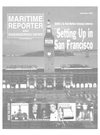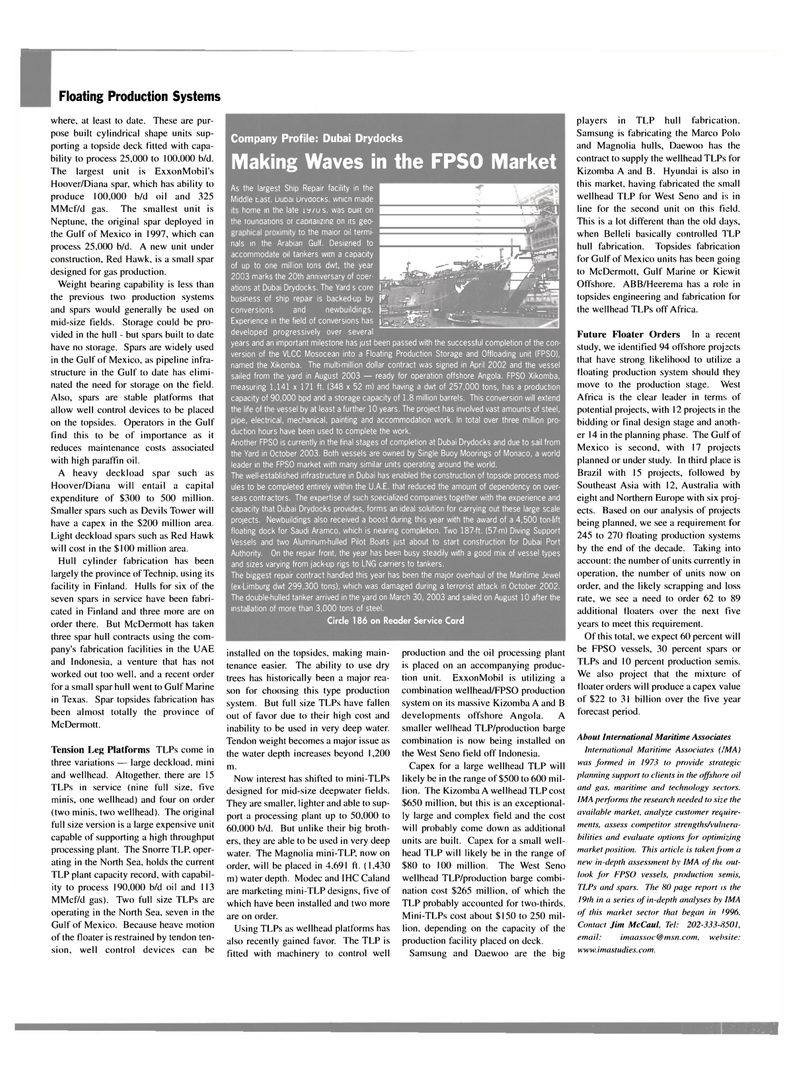
Page 56: of Maritime Reporter Magazine (September 2003)
Read this page in Pdf, Flash or Html5 edition of September 2003 Maritime Reporter Magazine
Floating Production Systems
Company Profile: Dubai Drydocks
Making Waves in the FPSO Market
As the largest Ship Repair facility in the
Middle mad home the late was on J the on geo- to the termi- h nals the to accommodate tankers a capacity ^BBMtf^l of up to one million tons dwt, the year ^^BS^Wt^^^^lB^^^^^m 2003 marks the 20th anniversary of oper- H9Bf^^W^' .j* ations at Dubai Drydocks. The Yard's core J- ' ^ ' V^M business of ship repair is backed-up by * conversions and newbuildings. jsSlS^ij*- . *" —
Experience in the field of conversions has .v., ^—• ^ developed progressively over several years and an important milestone has just been passed with the successful completion of the con- version of the VLCC Mosocean into a Floating Production Storage and Offloading unit (FPSO), named the Xikomba. The multi-million dollar contract was signed in April 2002 and the vessel sailed from the yard in August 2003 — ready for operation offshore Angola. FPSO Xikomba, measuring 1,141 x 171 ft. (348 x 52 m) and having a dwt of 257,000 tons, has a production capacity of 90,000 bpd and a storage capacity of 1.8 million barrels. This conversion will extend the life of the vessel by at least a further 10 years. The project has involved vast amounts of steel, pipe, electrical, mechanical, painting and accommodation work. In total over three million pro- duction hours have been used to complete the work.
Another FPSO is currently in the final stages of completion at Dubai Drydocks and due to sail from the Yard in October 2003. Both vessels are owned by Single Buoy Moorings of Monaco, a world leader in the FPSO market with many similar units operating around the world.
The well-established infrastructure in Dubai has enabled the construction of topside process mod- ules to be completed entirely within the U.A.E. that reduced the amount of dependency on over- seas contractors. The expertise of such specialized companies together with the experience and capacity that Dubai Drydocks provides, forms an ideal solution for carrying out these large scale projects. Newbuildings also received a boost during this year with the award of a 4,500 ton-lift floating dock for Saudi Aramco, which is nearing completion. Two 187-ft. (57-m) Diving Support
Vessels and two Aluminum-hulled Pilot Boats just about to start construction for Dubai Port
Authority. On the repair front, the year has been busy steadily with a good mix of vessel types and sizes varying from jack-up rigs to LNG carriers to tankers.
The biggest repair contract handled this year has been the major overhaul of the Maritime Jewel (ex-Limburg dwt 299,300 tons), which was damaged during a terrorist attack in October 2002.
The double-hulled tanker arrived in the yard on March 30, 2003 and sailed on August 10 after the installation of more than 3,000 tons of steel.
Circle 186 on Reader Service Card where, at least to date. These are pur- pose built cylindrical shape units sup- porting a topside deck fitted with capa- bility to process 25,000 to 100,000 b/d.
The largest unit is ExxonMobil's
Hoover/Diana spar, which has ability to produce 100,000 b/d oil and 325
MMcf/d gas. The smallest unit is
Neptune, the original spar deployed in the Gulf of Mexico in 1997, which can process 25,000 b/d. A new unit under construction. Red Hawk, is a small spar designed for gas production.
Weight bearing capability is less than the previous two production systems and spars would generally be used on mid-size fields. Storage could be pro- vided in the hull - but spars built to date have no storage. Spars are widely used in the Gulf of Mexico, as pipeline infra- structure in the Gulf to date has elimi- nated the need for storage on the field.
Also, spars are stable platforms that allow well control devices to be placed on the topsides. Operators in the Gulf find this to be of importance as it reduces maintenance costs associated with high paraffin oil.
A heavy deckload spar such as
Hoover/Diana will entail a capital expenditure of $300 to 500 million.
Smaller spars such as Devils Tower will have a capex in the $200 million area.
Light deckload spars such as Red Hawk will cost in the $100 million area.
Hull cylinder fabrication has been largely the province of Technip, using its facility in Finland. Hulls for six of the seven spars in service have been fabri- cated in Finland and three more are on order there. But McDermott has taken three spar hull contracts using the com- pany's fabrication facilities in the UAE and Indonesia, a venture that has not worked out too well, and a recent order for a small spar hull went to Gulf Marine in Texas. Spar topsides fabrication has been almost totally the province of
McDermott.
Tension Leg Platforms TLPs come in three variations — large deckload, mini and wellhead. Altogether, there are 15
TLPs in service (nine full size, five minis, one wellhead) and four on order (two minis, two wellhead). The original full size version is a large expensive unit capable of supporting a high throughput processing plant. The Snorre TLP, oper- ating in the North Sea, holds the current
TLP plant capacity record, with capabil- ity to process 190,000 b/d oil and 113
MMcf/d gas). Two full size TLPs are operating in the North Sea, seven in the
Gulf of Mexico. Because heave motion of the floater is restrained by tendon ten- sion, well control devices can be installed on the topsides, making main- tenance easier. The ability to use dry trees has historically been a major rea- son for choosing this type production system. But full size TLPs have fallen out of favor due to their high cost and inability to be used in very deep water.
Tendon weight becomes a major issue as the water depth increases beyond 1,200 m.
Now interest has shifted to mini-TLPs designed for mid-size deepwater fields.
They are smaller, lighter and able to sup- port a processing plant up to 50,000 to 60,000 b/d. But unlike their big broth- ers, they are able to be used in very deep water. The Magnolia mini-TLP, now on order, will be placed in 4,691 ft. (1,430 m) water depth. Modec and IHC Caland are marketing mini-TLP designs, five of which have been installed and two more are on order.
Using TLPs as wellhead platforms has also recently gained favor. The TLP is fitted with machinery to control well production and the oil processing plant is placed on an accompanying produc- tion unit. ExxonMobil is utilizing a combination wellhead/FPSO production system on its massive Kizomba A and B developments offshore Angola. A smaller wellhead TLP/production barge combination is now being installed on the West Seno field off Indonesia.
Capex for a large wellhead TLP will likely be in the range of $500 to 600 mil- lion. The Kizomba A wellhead TLP cost $650 million, but this is an exceptional- ly large and complex field and the cost will probably come down as additional units are built. Capex for a small well- head TLP will likely be in the range of $80 to 100 million. The West Seno wellhead TLP/production barge combi- nation cost $265 million, of which the
TLP probably accounted for two-thirds.
Mini-TLPs cost about $150 to 250 mil- lion. depending on the capacity of the production facility placed on deck.
Samsung and Daewoo are the big players in TLP hull fabrication.
Samsung is fabricating the Marco Polo and Magnolia hulls, Daewoo has the contract to supply the wellhead TLPs for
Kizomba A and B. Hyundai is also in this market, having fabricated the small wellhead TLP for West Seno and is in line for the second unit on this field.
This is a lot different than the old days, when Belleli basically controlled TLP hull fabrication. Topsides fabrication for Gulf of Mexico units has been going to McDermott, Gulf Marine or Kiewit
Offshore. ABB/Heerema has a role in topsides engineering and fabrication for the wellhead TLPs off Africa.
Future Floater Orders In a recent study, we identified 94 offshore projects that have strong likelihood to utilize a floating production system should they move to the production stage. West
Africa is the clear leader in terms of potential projects, with 12 projects in the bidding or final design stage and anath- er 14 in the planning phase. The Gulf of
Mexico is second, with 17 projects planned or under study. In third place is
Brazil with 15 projects, followed by
Southeast Asia with 12, Australia with eight and Northern Europe with six proj- ects. Based on our analysis of projects being planned, we see a requirement for 245 to 270 floating production systems by the end of the decade. Taking into account: the number of units currently in operation, the number of units now on order, and the likely scrapping and loss rate, we see a need to order 62 to 89 additional floaters over the next five years to meet this requirement.
Of this total, we expect 60 percent will be FPSO vessels, 30 percent spars or
TLPs and 10 percent production semis.
We also project that the mixture of floater orders will produce a capex value of $22 to 31 billion over the five year forecast period.
About InternationaI Maritime Associates
International Maritime Associates (/MA) was formed in 1973 to provide strategic planning support to clients in the offshore oil and gas, maritime and technology sectors.
IMA performs the research needed to size the available market, analyze customer require- ments, assess competitor strengths/vulnera- bilities and evaluate options for optimizing market position. This article is taken from a new in-depth assessment by IMA of the out- look for FPSO vessels, production semis,
TLPs and spars. The HO page report is the 19th in a series of in-depth analyses by IMA of this market sector that began in 1996.
Contact Jim MeCaul, Tel: 202-333-8501, email: [email protected], website: www. imastudies. com.

 55
55

 57
57
